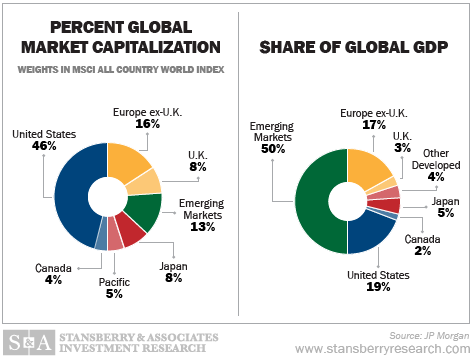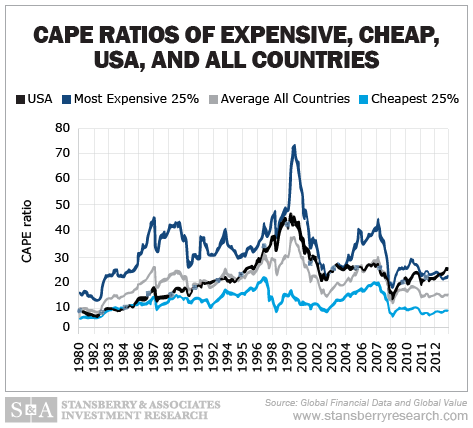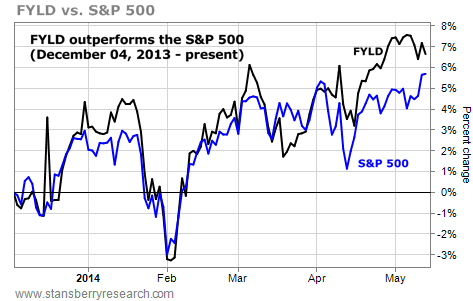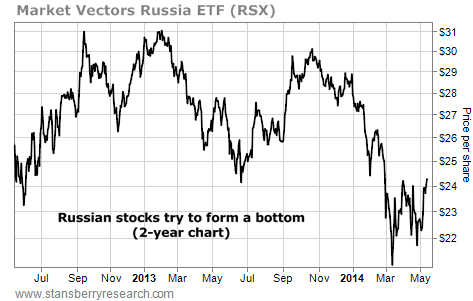| Home | About Us | Resources | Archive | Free Reports | Market Window |
It's Time to Start Moving Money into Foreign StocksBy
Thursday, May 15, 2014
If you're a U.S. investor, you're making a big mistake… Even the experts are making this mistake.
I'm talking about "home-country bias" – the idea that most investors have way too much money allocated to their native country.
And today, I'm going to share a simple "one click" way to get you started fixing it.
According to Vanguard, U.S. investors put an average of about 70% of their stock market money into U.S. companies. But as my friend and colleague Meb Faber showed in his book Global Value, U.S. stocks make up only 46% of the world's market cap and the U.S. makes up only 19% of the world's gross domestic product.
 Plus, if you're a U.S. citizen, you likely have a job, property, and other interests in the country. However you measure it, it's likely you have too many eggs in one basket. And that's particularly true right now…
Take a look at the chart below. It compares the "CAPE" ratio of the U.S. to the world's average, the most expensive countries, and the least expensive countries. As you can see, the U.S. is on the expensive side.
 The CAPE is the "cyclically adjusted price-to-earnings ratio." While it's not a perfect measure of value, other measures of value also indicate that the U.S. isn't a bargain. I'm not saying U.S. stocks are in a bubble. I'm still finding good opportunities. But now is a good time to consider re-allocating some of the capital you have in U.S. stocks to other, cheaper countries.
One of the easiest ways to do this is with Meb's Cambria Foreign Shareholder Yield Fund (FYLD).
FYLD holds about 100 stocks in non-U.S. developed countries. It has large weightings in Europe, Canada, and Japan. It focuses on companies that have a history of rewarding shareholders with dividends and buybacks. And it screens for good values and positive price action. (You can learn more about it right here.)
The fund just launched in December, but you can see that since inception, it has beaten the S&P 500.
 FYLD's holdings offer better value and more income than the U.S. market, too. Take a look:
The fund's average price-to-book value of 1.3 is half as much as the S&P 500… Its price-to-sales ratio is only about one-third of the S&P 500… And with a yield of 4.8%, it offers more than twice as much income as U.S. stocks right now. With its focus on shareholder yield and on cheaper developed markets, we expect FYLD to continue to outperform U.S. stocks. Depending on global market volatility, you could see double-digit annual returns for years to come.
And if you're a U.S. investor, it's probably time for you to start lightening up on your home-country allocation.
Foreign markets are a better value right now. And FYLD is a high-income way to put your money to work abroad.
Good investing,
Amber Lee Mason
Further Reading:
Amber recently recommended another trade that's hard for many U.S. investors to make. "I've never gotten more angry notes," she writes. "Nobody wants to make that bet." But she reminds us that "often, the hard trades are the right trades." Get all the details here.
Earlier this week, Amber showed Growth Stock Wire readers what they can realistically expect to make in the market. "Way on the losing end, past even inflation, you'll find the average investor's returns," she writes. "But folks who can master these basics will do far, far better..." Learn what they are right here.
Market NotesHAS RUSSIA BOTTOMED? Have Russian stocks suffered the worst the market can throw at them? We'll consider the idea today...
Russian stocks are some of the world's most despised securities. Most analysts view Russian president Vladimir Putin as a gangster. In response to his dealings in Ukraine, western countries have slapped sanctions on Russia. They are harming the country's businesses.
One way to track Russian stocks is with the Market Vectors Russia ETF. It's a diversified basket of Russian stocks. In response to the Ukraine crisis, this fund fell from $29 per share to around $21 per share. Since then, the fund has bounced back to the $24-$25 area.
Since that big fall, some contrarian investors have been buying the Russian market. They say the negative sentiment has made Russia one of the cheapest markets in the world. Some of its biggest firms are trading for less than five times earnings. You want a cheap and out-of-favor market? Russia is near the top of the list.
 |
Recent Articles
|


